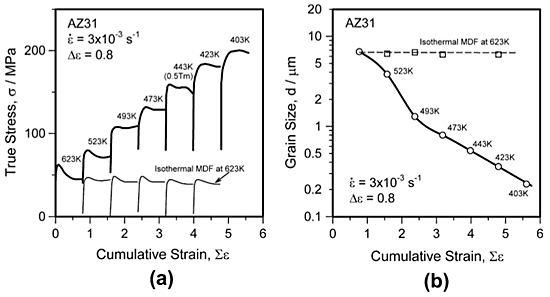The mechanisms of new microstructural evolution produced by two types of dynamic recrystallizations including those brought by severe plastic deformation (SPD) are reviewed. At elevated temperatures, new grains evolve by nucleation and growth in materials with low to medium stacking fault energies (SFE) by a mechanism of the conventional discontinuous dynamic recrystallization (dDRX). On the other hand, at relatively low temperatures, new ultrafine grains can be produced in any material irrespective of the SFE by means of SPD. This in situ or continuous dynamic recrystallization (cDRX) process is still not perfectly understood. This is because many SPD methods provide data concerning the microstructural changes that take place but little information regarding the flow stress behavior. By contrast, multi-directional forging (MDF) provides both types of data concurrently (Fig. 1). Grain refinement was carried out by both mechanisms of cDRX and SPD. Recent studies of the deformation behavior of metals and alloys under SPD conditions, carried out using MDF as well as other SPD methods, are synthesized and the links between the microstructural and mechanical observations are examined carefully. Some models for grain formation under SPD conditions are discussed. These result from the gradual transformation from the dislocation sub-boundaries produced at low strains into ultrafine grains with high angle boundaries at large strains with aid of crystal rotations (Fig. 2). Next, the post-dynamic recrystallization behavior, i.e. that of annealing after both dDRX and cDRX, is described. The differing annealing behaviors result from the differences in the natures of the deformed microstructures. Finally, an integrated recrystallization model for these phenomena, i.e. dynamic and static recrystallization of both the continuous and discontinuous types, is presented and discussed. The application of cDRX and dDRX to microstructure control should be studied more systematically, particularly in materials not subject to allotropic transformation, i.e. in most of the nonferrous metals and alloys as well as in ferritic steels and austenitic alloy steels. The microstructure control techniques employed to date in these materials have been limited almost entirely to static annealing following cold working. Specific methods of grain refinement applicable to particular alloy systems should be developed using the principles of dDRX and cDRX processing, as appropriate. However, there are several unresolved topics requiring clarification with respect to the dynamic evolution of the strain-induced grains produced by cDRX.
Dynamic and post-dynamic recrystallization under hot, cold and
severe plastic deformation conditions
[Progress in Materials Science Vol. 60 (2014) pp. 130![]() 207.]
207.]
 |
|
|
Fig. 1 (a) True stress-true strain curves of Mg alloy AZ31 during MDF at 623 K (thin line) and MDF at temperatures decreasing from 623 K to 403 K (thick line). The pass strain De was 0.8. (b) Changes in grain size during MDF at 623 K (broken line) and at temperatures decreasing from 623 K to 403 K (solid line). |
 |
|
|
Fig. 2 Schematic model of UFG formation from cell structures based on TEM observations of the microstructures developed under SPD conditions. The misorientations between the sub-boundaries increase with strain and approach those of HABs at large strains. |